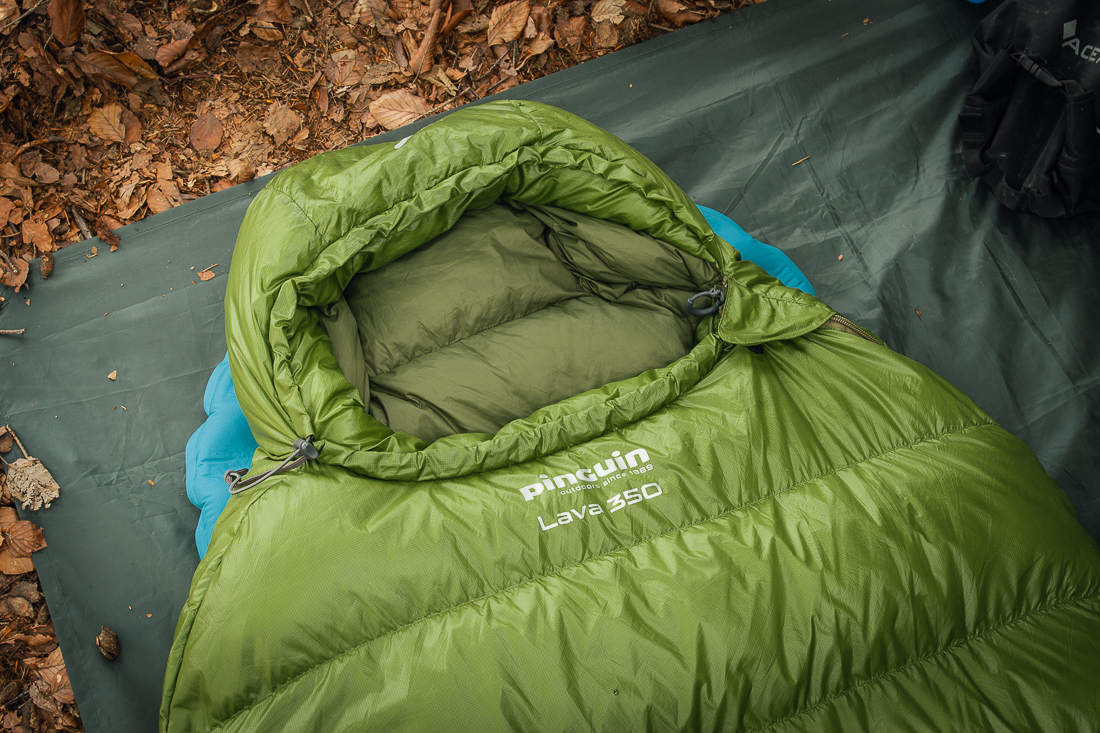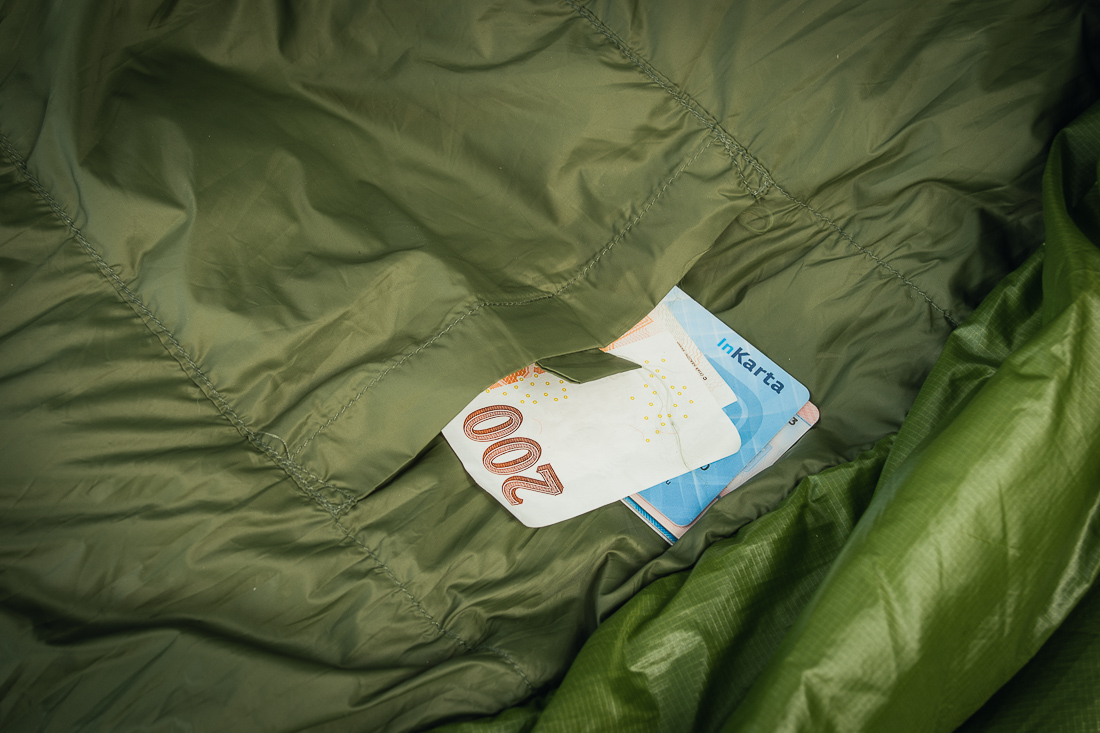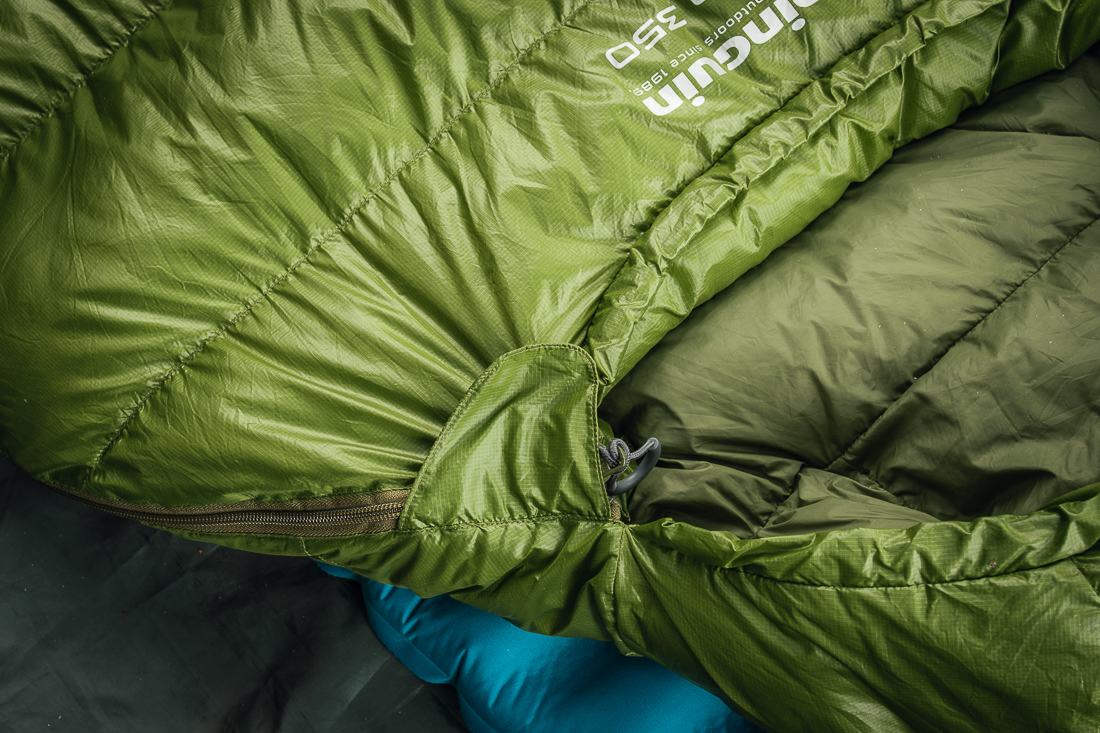When I was thinking about how I would approach this test, thoughts were creeping into my head that it would probably not be a classical testing on my part, but rather a fleeting acquaintance and discovery through the eyes of a cyclist and, according to many, even a "crazy hammock maker" (I don't agree with this expression, of course!) with Pinguin's latest product in the form of their summer down sleeping bag Lava 350.
Thanks to Pinguin for lending us the Lava 350 down sleeping bag for the test.
In a sense, it was a chance encounter for me, because I had finished sleeping on the ground years ago and now I had to reminisce during the SwiftCampout gathering in Kokořínsko, which I will get to. But maybe that’s why I was able to look at the whole thing more critically, i.e. through the eyes of a basically novice bikepacker. I still find some people very suspicious about using down fillers compared to cheaper microfiber alternatives, i.e. the notion that you get more music for less money with microfiber. So let’s take a look at that.
That was so…
One day Dag sent me a message that there would be a SwiftCampout meeting again, that they were going to sleep under an rock overhang, so I shouldn’t even think about hanging in a hammock. I checked the map and it was immediately clear that he was right and that I would definitely not miss sleeping under such a notorious rock overhang. Quite quickly we arranged everything with the guys from Pinguin Outdoors and a few days later a package with their new sleeping bag landed at my house. Upon unpacking, I was very pleasantly surprised by the nice green color, which is absolutely perfect for me. It doesn’t look militaristic in any way and is literally calming. In addition to this shade, the Lava 350 is also available in petrol, which is another perfect shade in my opinion. Here it really helped that the manufacturer did not choose garish colours. Everything is subtle, as tasteful as nature itself. I’d almost say that if you just dropped the sleeping bag in the landscape, it would look like it’s been there forever. The colours are simply too good and thanks for them!
Teflon Hydrophobic RDS Down 650 Cuin
The day before I leave for SwiftCampout, I plan my MTB route in Kommot and transfer it to Mapy.cz. I should have an easy 75 km to go. But the next day everything started different. It has been raining harder than it has in a long time. I postpone my departure as long as possible, but finally, despite the rain, I get on my bike and play the machine voice of the navigation system into one of my headphones. If I don’t leave now, there’s no point in going to the SwiftCampout, and I can’t do that to the boys. I have 11:30 AM on my watch. This is the beginning of a little hell for me, because all the way to Kokořínsko, where the reunion is, it rains continuously. Eight hours on Saturday in constant, never-ending rain, but the all-important cycling bag (Acepac Drybag 16L), in which I had everything I needed for sleeping, including spare clothes, was completely waterproof. And yet it’s “just” nylon with TPU lamination. The Revelate frame bag, on the other hand, got slightly wet. Moisture gradually rose around the zippers and through the seams. Fortunately, I only had camping gear in the frame bag this time. Everybody wants bags these days, preferably made of X-PAC material, because that’s what everybody does and because it’s fashionable. However, few manufacturers also create a quality seamless connection or, conversely, secure critical areas like Acepac did with their Drybags. Fortunately, this small Czech company thinks.
I finally “swam” under the overhang at half past eight in the evening, completely through. On the spot I greeted Dag and Roman. I quickly prepare my sleeping bag and take it out, which I knock through and let it “gain loft”. There is a lot of moisture in the air after the day’s rain, and I am glad for the DWR (durable water repellent) treatment on the nylon cover fabric. All the more so the moment I stumble over a log and dribble hot tea from my mug straight onto my sleeping bag. It immediately drained out of the sleeping bag! That’s what happens when you leave your headlamp at home. In addition to this treatment, Pinguin also gives the feathers a Teflon treatment. According to the manufacturer, this improves drying, which in turn has the effect of keeping the down warm and fluffy even after years of use. After washing, it should also regain its original loft more easily and quickly thanks to this treatment. The duck feathers used are also fully RDS (Responsible Down Standard) certified, meaning they are guaranteed not to come from animals that would be subjected to unnecessary injury and stress. To find out more about RDS on textileexchange.org.
The manufacturer also lists the following temperature parameters. Comfort 2 °C, limit -4 °C (comfort for men), extreme – 20 °C. The only thing I can say is that in both cases I had around 17 °C at night and I was perfect. I wore only light summer underwear made of merino wool (long pants and sleeves) and light merino socks. I recommend this nighttime gear to everyone if they want their down to last for years, maybe even decades.
Always change your clothes before you go to sleep. Do not use man-made fibres or cotton! The skin fat that your body expels during the night sticks to the surface of synthetic fibres and passes through to the feathers. Cotton, on the other hand, will absorb water very slowly. Clothing made of merino wool, on the other hand, is very suitable. Wool can pull fat into itself and hold it in. The wrong clothing will usually make your insulation look several years old after two months of use. Remember that damp clothing that you have walked dozens of miles in will suck the heat out of you at night.
650 Cuin at Lava still doesn’t provide extremely good collapsibility, but does it matter?
The down filling itself is duck feather with a 650 Cuin fill ratio of 90/10, which provides reasonable loft.
Additionally, the construction of the sleeping bag relies on baffles that have an “H” chamber design, which means the Lava doesn’t suffer from cold seams. If you don’t know exactly what fill rate means, remember the following lesson.
Cuin is a unit of down filliness and is an industry standard that determines relatively accurately how high quality the down used is. That is, how much 28.4 grams (1 ounce) of feather volume occupies the space of one cubic inch. The higher the quality of the feather, the more volume it will occupy and thus the higher the Cuin value. A larger occupied volume then means the down insulation will be more fluffy (have more air around it – technically loft).
But since Dag and Roman were also at the meeting, I had a chance to compare the Lava with their sleeping bags and I had to say that the packability of the Lava was a bit worse. To the touch, it seemed to me that it was the fault of the outer and inner covering material, which seemed a bit less soft than in their sleeping bags. In reality, the top fabric (ultralight ripstop Nylon) and the inner fabric (ultralight polyester) are both 20D. The manufacturer did not want to use 10D because it would make the product more expensive and the durability would be reduced. Even so, you will of course argue that I must have compared sleeping bags of completely different categories, and you would be right. However, it’s also good to know that the Lava stands up very reasonably for our price/performance ratio and, thanks to the material used, should last a really long time according to the manufacturer. At this price level, I personally find the packability very good indeed. Look at it this way, I was able to pack the Lava, a Peak 25 NX air mattress and my overnight clothes into a 16L drybag. If I were packing Dag’s Cumulus, I’d probably put a spare shirt, underwear and a mini first aid kit in there. Whether it’s worth the significantly higher investment to make room for these items, I leave up to you. For me, though, the packability for the casual cyclist is absolutely fine.
I was so tired at SwiftCampout that I didn’t test the sleeping bag any more and I fell asleep like a leech. I probably would have fallen asleep wrapped in a sheet then. 😊 How was the night? An owl hooted now and then, something rustled somewhere. Under the overhang one could hear rodents, of which Roman has an incomprehensible fear, so he hung his provisions on a tree as far away from the overhang as possible before going to bed, as if we were expecting a visit from a bear here in Kokořínsko. I just shook my head and sipped my tea.
But back to the night and the sleeping bag. Lava has one huge advantage for me, but take it purely as my subjective view. Personally, I’m very spoiled from sleeping in a hammock. I’m used to stretching out comfortably and generally fidgeting and changing positions during sleep. What I really can’t stand is cramped sleeping. It usually makes me feel like someone is trying bondage on me. The Lava is quite roomy, though. It’s not a “pure mummy,” and I’m glad for that. In my opinion, this is definitely a big advantage for casual travel, but of course a big disadvantage for someone who might want to take the Lava on, say, a more rugged expedition. In extreme situations, any extra space you have to heat up can mean some trouble. For travelling around Europe, however, I think this summer sleeping bag will be fantastic.
If you sleep in a hammock and don’t have a quilt, the Lava is also a decent hammock alternative. I’ve tried. If you unzip the extra sleeping bag and keep the footbox (enclosed space for feet and calves), you’re good to go, and you can put off buying a quilt for better times. I can even imagine taking, for example, a winter quilt in the extreme and if that wasn’t enough, a Lava and packing into both. If you don’t know what I mean, check out Shug’s nice video: Layering Underquilts, Top Quilts and Sleeping Bags for Deep Winter Camping – YouTube.
Road to Klondajk
Since it was not tested and especially not photographed, I made another trip with Lava, this time to my favourite Brda. I went to the Brda ridges to the area below the former missile base known as Klondajk. I headed to the campsite where my son first slept under the open sky and which we later named Wasp Camp, because during one of our sleepovers together in the evening he stepped on a trip hole of underground wasps and got seven stings. I stayed up all night watching him and taking his temperature. Over the phone, I had arranged with the closest friend who would come get us if my son’s condition worsened in any way. Fortunately, everything turned out well that day and we also found out that we were not allergic to wasp venom. Today, when I visited the place again after several years, I was literally horrified. The campsite, which was originally located in a deep forest, was suddenly only twenty meters from its edge and then the “moonscape” began. Unfortunately, the bark beetle had taken over here as well, and a clearing the size of several football fields had spread out in the woods below Klondajk. Not a pretty sight at all. In addition, other preparatory work can be seen at the edges of the huge clearing. Probably a lot more will go away this year. ☹
To come to better thoughts, I repaired the neglected fireplace and began to prepare a place to sleep. I stretched my tarp from Lesovik between two trees, staked a cell on the ground, inflated my Peak 25 car mattress and set up my sleeping bag. This is also where most of the photos you are looking at now came from. I arrived early, so I had time to study Lava more.
The craftsmanship is top-notch with a star
On closer inspection, the Lava impresses with the quality of the stitching. All the seams are precise, nothing seams, no threads peeking through. I didn’t even find a place where the sewing of two materials together somehow didn’t work. And believe me, I’ve encountered this with much more expensive products. The sewing is simply beyond reproach.
Lava is equipped with a zipper from the Japanese company YKK. This in itself is a guarantee that the zipper will last for years. Pinguin has clearly bet on durability over time. The zipper is also fitted with a plastic anti-snag protection and I can confirm that it works perfectly.
It’s also good to know that you can buy the sleeping bag as a “tandem”, i.e. you can combine two Lavas, or always the left and right version of the sleeping bag.
Note: If you go for it, don’t really buy two of the same with a zipper on the left or just on the right! Once again. If you want to sleep with your boyfriend, girlfriend in one “bag”, you have to buy one sleeping bag with a left zipper and one with a right zipper.
Along the entire length of the inner side of the zipper, you will also find an inner covering band filled with feathers, which prevents heat from escaping through the zipper. Another nice addition are the scarves at the head. The hood around the head is tightened with two cords, or a round elastic and a flat drawstring – according to the manufacturer, this is especially good in the dark, when you can tell which part of the hood you’re tightening. The entire head opening is also equipped with an additional collar, so that precious warmth around your head and neck really doesn’t escape. I liked that the manufacturer also remembered the inner pocket, which is waterproof for sure for valuables you want to carry.
Lava is of course finished with two loops at the feet, which are used to hang the sleeping bag. This is also, by the way, the recommended storage method. And we’ll get to that right away.
How to store and how is Lava in terms of weight?
The size of my Lava is for a figure up to 185 cm and I have also completely overweighted the sleeping bag. The result can be found in the table below. In addition to the sleeping bag itself, you will receive one compression carrying case. This makes sense for me especially when walking with a backpack. Do not take the compression pack for bikepacking. That’s what you have the compression bags for. The sleeping bag itself will nicely squeeze out every unfilled nook and cranny in your bikepacking panniers. Plus, when bikepacking, you have the option of splitting your load into multiple bags, but you usually don’t have that many options with a backpack. That’s why I personally do more “packing” with a backpack.
The second pack you get is a much larger bag designed for sleeping bag storage. The bag is an alternative, especially if you don’t have room at home to hang your sleeping bag (yes, for the two loops). It’s up to you how you store it. The bottom line is never store a sleeping bag in a compression pack for long periods of time. I won’t say more on storage because the article is already over two thousand words long and who wants to read that long. I hear people don’t read and prefer to watch YouTube videos. A friend of mine said that to me recently…
And the promised table…
| Packed dimensions | Compressed dimensions | Weight | Weight incl. compression sack. | |
| Declared | Ø18 x 30 cm | Ø18 x 27 cm | 779 g | N/A |
| Measured | Ø18 x 35 cm | 19 x 28 cm | 784 g | 849 g |

Price
197 Eur

Weight
784 g

Material
Nylon superlight 20D Ripstop

























 197 Eur
197 Eur 784 g
784 g Nylon superlight 20D Ripstop
Nylon superlight 20D Ripstop
Discussion